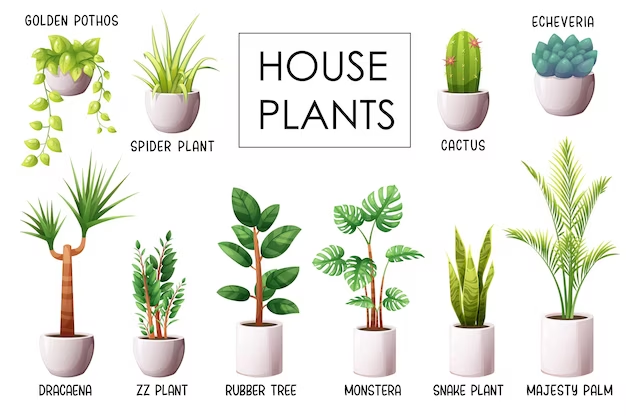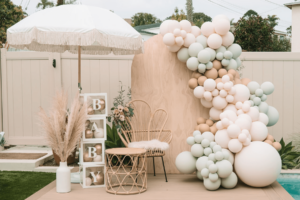Indoor Plants with Names: A Guide to the Best Choices for Your Home?

Indoor plants add beauty to your living space, purify the air, improve mood, and bring a touch of nature indoors. For those interested in enhancing their home’s ambiance with indoor greenery, understanding the unique characteristics of different plants can help you choose the perfect fit. This article explores popular indoor plants with names, discussing their care requirements, benefits, and placement tips. Whether you’re a seasoned plant lover or just starting, this guide will help you find the best indoor plants to enrich your space.
Snake Plant (Sansevieria trifasciata)
Snake plants, also known as mother-in-law’s tongues, are among the most popular indoor plants due to their resilience and low maintenance. These hardy plants feature tall, sword-like leaves with green and yellow variegation.
Care Tips:
- Light: Thrives in low to bright, indirect sunlight.
- Water: Requires infrequent watering, approximately once every two weeks.
- Benefits: Excellent air purifier, removing toxins like formaldehyde and benzene.
Snake plants are perfect for beginners and ideal for offices or low-light areas in your home.
Monstera Deliciosa (Swiss Cheese Plant)
The Monstera deliciosa, the Swiss cheese plant, is known for its large, glossy leaves with unique holes. This tropical plant adds an exotic vibe to any room, making it a favorite among plant enthusiasts.
Care Tips:
- Light: Prefers bright, indirect sunlight.
- Water: Requires regular watering but should be allowed to dry out between waterings.
- Benefits: It provides a lush, green appearance and can grow large, making it a statement piece.
Monsteras are ideal for spacious rooms and add a touch of jungle flair to your home.
Peace Lily (Spathiphyllum)
Peace lilies are beautiful indoor plants with striking white flowers that bloom periodically. Known for their elegance and air-purifying properties, peace lilies are easy to care for and thrive indoors.
Care Tips:
- Light: Prefers low to medium, indirect light.
- Water: Water when the top inch of soil is dry.
- Benefits: Known to remove pollutants like ammonia and benzene from the air.
Peace lilies are perfect for low-light areas and add a touch of grace to any room.
ZZ Plant (Zamioculcas zamiifolia)
The ZZ plant is a low-maintenance indoor plant with glossy, oval-shaped leaves that grow upright. It thrives in low-light conditions, ideal for offices or dimly lit spaces.
Care Tips:
- Light: Tolerates low to bright, indirect light.
- Water: Water sparingly; ZZ plants are drought-tolerant.
- Benefits: Great air purifier and extremely hardy.
ZZ plants are resilient and can withstand neglect, making them perfect for busy or first-time plant owners.
Pothos (Epipremnum aureum)
Pothos, also known as devil’s ivy, is a popular vining plant with heart-shaped leaves. It comes in various colors, including green, golden, and variegated, and is known for its fast-growing, trailing vines.
Care Tips:
- Light: Grows well in low to medium, indirect light.
- Water: Water when the top inch of soil feels dry.
- Benefits: Easy to propagate and an excellent air purifier.
Pothos is ideal for hanging baskets or shelves where its vines can cascade beautifully.
Spider Plant (Chlorophytum comosum)
Spider plants are known for their long, arching leaves and small “baby” plants, or offshoots, that dangle from the mother plant. These resilient plants quickly grow and adapt well to various indoor conditions.
Care Tips:
- Light: Prefers bright, indirect light but tolerates low light.
- Water: Keep the soil moist, watering when the top inch is dry.
- Benefits: Removes toxins like carbon monoxide and formaldehyde from the air.
Spider plants are child- and pet-friendly, making them an excellent choice for homes with children or pets.
Fiddle Leaf Fig (Ficus lyrata)
The fiddle leaf fig is a stylish indoor plant known for its large, violin-shaped leaves. It’s a bit more demanding than other indoor plants but well worth the effort if you want to make a statement.
Care Tips:
- Light: Needs bright, indirect sunlight.
- Water: Water when the top inch of soil is dry, ensuring good drainage.
- Benefits: Adds a modern, upscale look to any room.
Fiddle leaf figs require a bit more care, but they are a stunning addition to any space and worth the attention they demand.
Rubber Plant (Ficus elastica)
Rubber plants have broad, glossy leaves and can grow quite tall, making them perfect for adding height and greenery to your indoor decor. They are relatively low-maintenance and can adapt to different environments.
Care Tips:
- Light: Prefers bright, indirect light but tolerates low light.
- Water: Water when the top inch of soil feels dry, allowing the soil to dry out slightly between waterings.
- Benefits: Good for filtering indoor air and is pretty resilient.
Rubber plants add a modern touch and are ideal for living rooms or office spaces with moderate sunlight.
Chinese Money Plant (Pilea peperomioides)
The Chinese Money plant, also known as the pancake plant, is known for its unique, round, coin-shaped leaves. This plant has gained popularity for its distinctive look and is considered a symbol of good fortune.
Care Tips:
- Light: Prefers bright, indirect sunlight.
- Water: Water when the top inch of soil is dry.
- Benefits: It brings a unique aesthetic and is easy to propagate.
Chinese Money plants are great for tabletops or desks, adding charm with their whimsical round leaves.
Aloe Vera
Aloe vera is a well-known succulent that not only adds beauty to your home but also has medicinal properties. Its gel-filled leaves are commonly used for treating burns and skin irritations.
Care Tips:
- Light: Requires bright, indirect sunlight.
- Water: Water sparingly, allowing the soil to dry out between waterings.
- Benefits: It can be a natural remedy for minor skin issues.
Aloe vera is perfect for sunny spots in your home and is ideal for those who prefer low-maintenance plants with added benefits.
Conclusion
Adding indoor plants can transform your space, purify the air, and elevate your mood. With various options available, from low-light tolerant snake plants to statement-making fiddle leaf figs, there’s an indoor plant for every preference and level of care. This guide has highlighted popular indoor plants with names, each with unique characteristics and benefits.
Start with a few low-maintenance choices, like the ZZ or snake plant, and gradually expand your indoor garden as you gain confidence. Embracing indoor plants brings a piece of nature indoors, promoting tranquility and a healthier environment.



